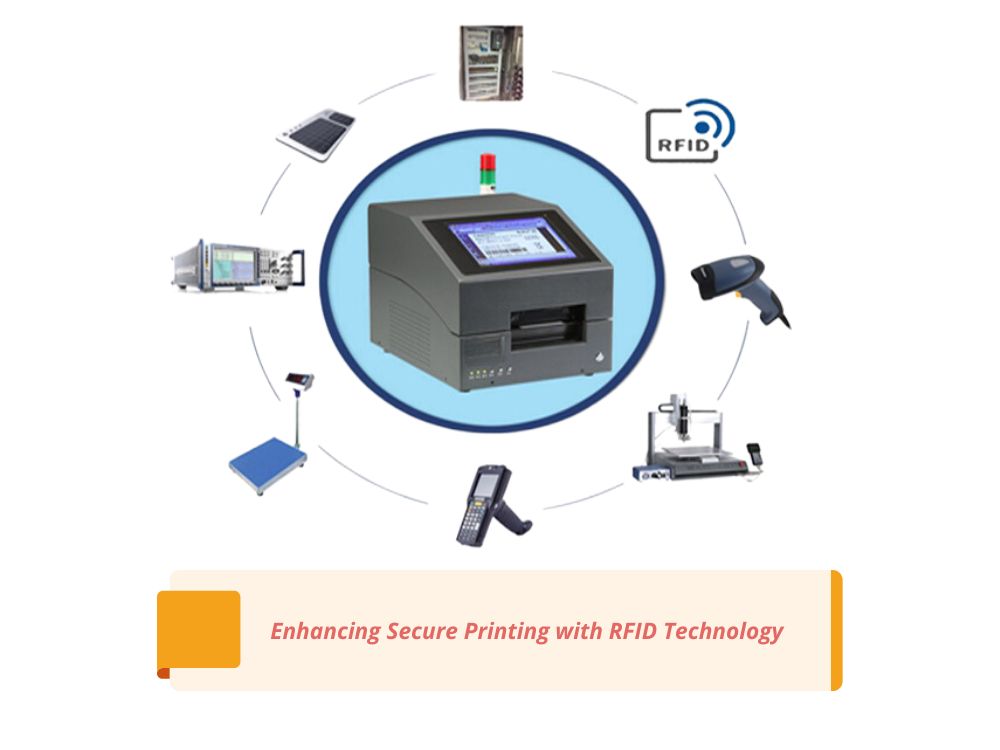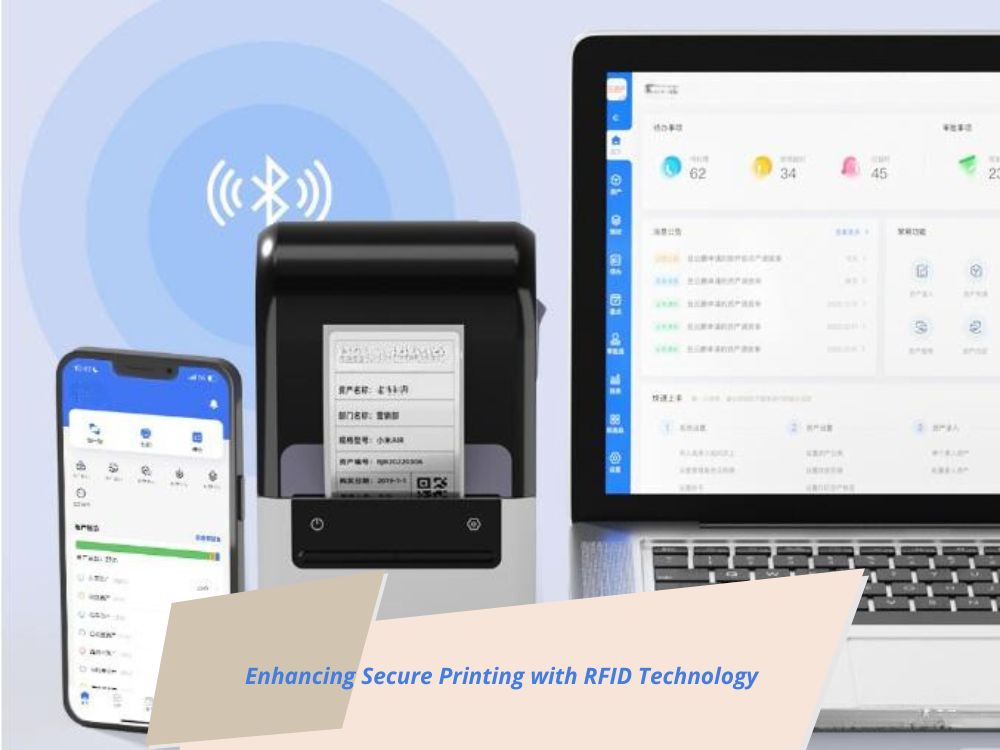
Enhancing Secure Printing with RFID Technology
Table of Contents
Summary
While traditional methods such as PINs and passwords have been the industry standard, RFID offers superior security, speed, simplicity, savings, and user satisfaction. The growing adoption of RFID in print management underscores its effectiveness in addressing the limitations of conventional systems.

The Security Advantage of RFID in Printing
Security is paramount in print management, especially when handling sensitive information such as HR records or financial data. Traditional PINs and passwords can be compromised through sharing or observation. In contrast, RFID cards, often doubling as employee IDs and access cards, provide enhanced security by being less susceptible to duplication or unauthorized use. RFID card readers can be programmed to recognize various data formats, adding layers of complexity that thwart potential security breaches.
Speed and Efficiency in Print Management
The cumbersome nature of entering usernames and passwords at printers can lead to delays and frustration, especially during peak times. RFID technology addresses this by enabling users to access their print jobs with a simple card scan, drastically reducing wait times. This efficiency not only improves productivity but also enhances the overall user experience by eliminating the need for manual input at the printer interface.
Aspect | PIN/Password-Based System | RFID-Based System |
Security | Prone to sharing and observation risks | Enhanced security, hard to duplicate |
Speed | Slower due to manual entry | Faster with card scan |
Simplicity | Requires remembering multiple credentials | Uses existing ID cards, no extra steps |
Savings | High IT support for password issues | Reduces IT workload, no additional cards |
User Satisfaction | Frustration with manual entry and delays | Higher satisfaction with ease of use |
Simplicity in Implementation and Use
RFID technology integrates seamlessly into existing infrastructure. Employees already carrying RFID-enabled ID cards for building access can use the same cards for print management, eliminating the need for additional items or credentials. For companies not yet using RFID, a simple RFID sticker can be added to existing ID cards. This approach ensures minimal disruption and requires virtually no training, as employees can quickly adapt to the new system.
Cost Savings Through RFID
One of the most tangible benefits of RFID in secure printing is the reduction in IT support needs. Frequent password resets and account unlocks consume considerable IT resources, especially in environments where employees manage multiple credentials. By adopting RFID, companies can significantly reduce the time IT staff spend on these tasks, leading to measurable cost savings. Additionally, the ability for employees to self-register their RFID cards for print management further alleviates the burden on IT departments.
User Satisfaction: A Key Outcome
The combination of time savings, simplicity, and reliability leads to higher user satisfaction. Employees no longer need to juggle multiple credentials, struggle with printer interfaces, or contact IT for support. Instead, RFID provides a seamless, efficient experience that works consistently, enhancing overall productivity and user contentment.
Conclusion: The Future of Print Management with RFID
The adoption of RFID technology for secure printing is not just a trend but a strategic move toward more efficient and secure operations. The advantages of RFID—ranging from enhanced security to cost savings—make it an attractive option for organizations seeking to modernize their print management systems. As more companies recognize these benefits, RFID is poised to become the new standard in secure printing.

Comments
Hot Products

What Is RFID Waste Management
Imagine a city where every trash bin speaks — not literally — but through a tiny chip that tells the system when it’s full, when it’s emptied, and where it went. That’s what RFID waste management is doing today.

What are Bolt Seals and their Applications? | Complete Guide
In global trade and logistics, bolt seals play a crucial role in ensuring cargo security and compliance. These small but powerful devices are designed to lock shipping containers, trailers, and cargo doors with a tamper-evident mechanism.

What is an RFID Card Protector? Benefits, Use Cases, and Buying Guide
RFID technology (Radio Frequency Identification) is everywhere: in your credit cards, ID badges, transit passes, hotel room keys, and more. It offers speed and convenience, but it also opens the door to a new kind of digital theft called “skimming.” That’s where an RFID card protector comes in.

RFID Wristbands for Events: Bulk Buying Guide for Organizers
RFID wristbands for events are becoming the go-to solution for organizers who need faster entry, fraud prevention, and cashless payments at concerts, festivals, and sports venues. Unlike paper tickets or QR codes, these smart wristbands use embedded chips to streamline access, secure transactions, and improve the guest experience.

How RFID Tag on Windscreen Improves Vehicle Access Control and Toll Systems
In today’s fast-paced world, vehicle identification needs to be quick, secure, and contactless. An RFID Tag on the Windscreen provides exactly that — a reliable way to manage toll collection, parking, and gated access without stopping vehicles.

The Benefits of RFID Linen Tags in Commercial Laundry
Managing laundry in hospitals, hotels, or large laundry services is a big job. Each day, thousands of sheets, towels, and uniforms are washed, sorted, and sent back out. But problems like lost linens, sorting mistakes, and manual counting can cost companies a lot of money. For example, mid-sized hotels can lose over $200,000 each year from missing linens.
That’s where RFID Linen Tags come in.
Tags
RELATED BLOGS

What Is RFID Waste Management
Imagine a city where every trash bin speaks — not literally — but through a tiny chip that tells the system when it’s full, when it’s emptied, and where it went. That’s what RFID waste management is doing today.

What are Bolt Seals and their Applications? | Complete Guide
In global trade and logistics, bolt seals play a crucial role in ensuring cargo security and compliance. These small but powerful devices are designed to lock shipping containers, trailers, and cargo doors with a tamper-evident mechanism.

What is an RFID Card Protector? Benefits, Use Cases, and Buying Guide
RFID technology (Radio Frequency Identification) is everywhere: in your credit cards, ID badges, transit passes, hotel room keys, and more. It offers speed and convenience, but it also opens the door to a new kind of digital theft called “skimming.” That’s where an RFID card protector comes in.




